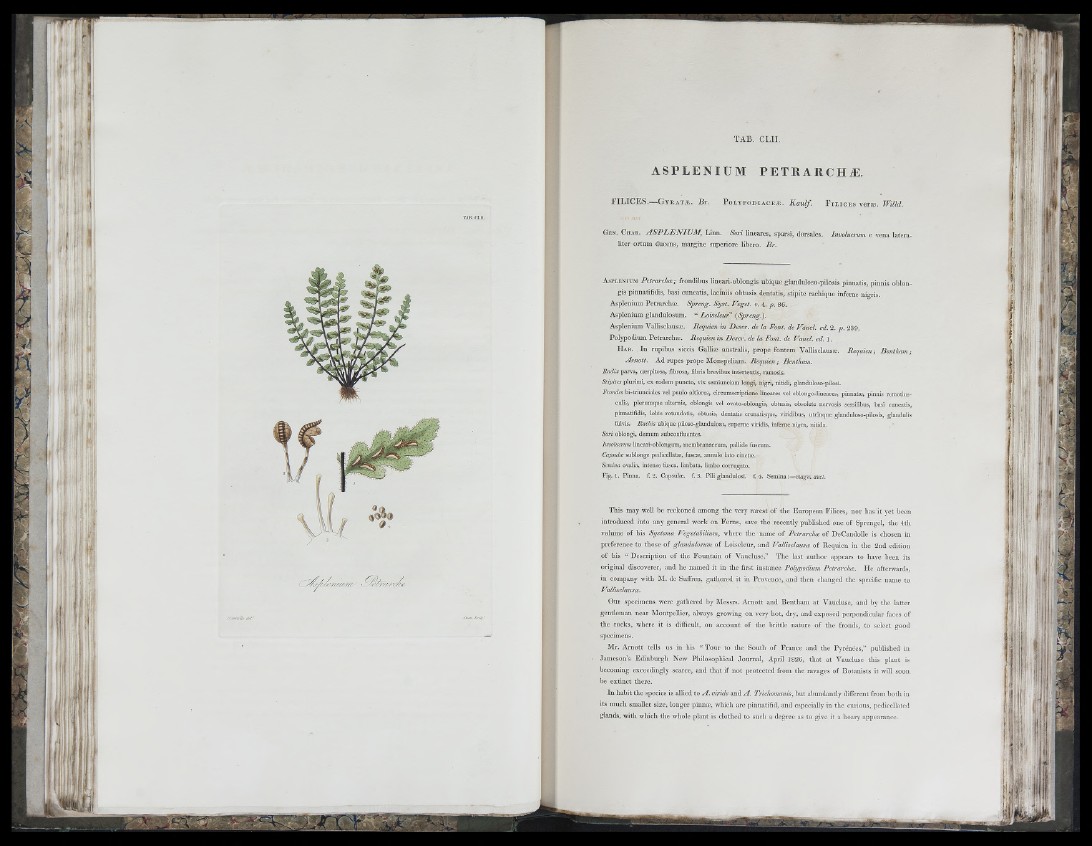
M fi
u; 'ii!*
ü I
A S P L E N I U M P E T R A R C HÆ.
l'TLICES.— G y r a t æ . J i v . P o l y p o d i a c e æ . K a u lf. F i l i c e s v e r æ . Willd.
G e n . C h a r . A S P L E N IU M , Lmn. Sori lineares, sparsi, dorsales. Involucrimi c vena latcra-
litcr ortum ducens, margine superiore libero. Br.
A s p l é n i u m Petrarcha; frondibus lineari-oblongis ubique glanduloso-pilosis pinnatis, pinnis ob lon g
is pinnatifidis, basi cuneatis, laciniis obtusis dentatis, stipite rachique infcrue nigris.
Asplenium Pctrarchæ. Spreng. Syst. Feget, v. 4 . p . 86.
Asplénium glandulosum. Loiseleur" [Spreng.).
Asplénium Vallisclausæ. B.equien in Descr. de la Font, de Fatici, cd. 2. p . 239.
P olypodium Petrarchæ. Requien in Descr. de la Font, de Fauci, ed. 1.
H a b . , In rupibus siccis Galliæ australis, propc foutem Vallisclausæ. Requien -, Bentham ;
Arnott. Ad rupes prope Monspeliam. Requien; Bentham.
R a d ix parva, coespitosa, fibrosa, fibris brevibus intertextis, ramosis.
S tip ites plurimi, e x eodem puncto, v ix semiunciam lon g i, nigri, nitidi, glanduloso-pilosi.
Frondes bi-triuuciales vel paulo altiores, circumscriptione lineares v e l oblongo-lineares, pinnatæ, pinnis remotiusculis,
plerumque alternis, oblongis v e l ovato-oblongis, obtusis, obsolete nervosis sessilibus, basi cuneatis,
pinnatifidis, lobis rotundatis, obtusis, dentatis crenatisque, viridibus, utrinque glanduloso-pilosis, glandulis
fulvis. R a c h is ubique pUoso-glandulosa, superne viridis, inferne nigra, nitida.
S o r i oblongi, demum subconfluentes.
Involucrum lineari-oblongum, membranaceum, pallide fuscum.
Cap sid a sublonge pedicellatæ, fuscæ, annulo lato cinctæ.
Semina ovalia, intense fusca, limbata, limbo corrugato.
Fig . 1. Pinna, f. 2. Capsuloe. f. 3. POi glandulosi. f. 4 . Semina mag«.
This may we ll be reckoned among th e very rarest o f th e European F ilic es, nor has it ye t been
introduced into any general work on Ferns, save th e recently published one o f Sprengel, the 4tli
volume o f h is Stjstenia Fegetahilium, where th e name o f Pctrarchæ o f DeCandolle is choseu in
preference to th o se o f glandulosum o f Loise lcur, and Fallisclatisæ o f Rcquicn in the 2nd edition
o f h is “ Description o f the Fountain o f Vauclusc.” The last author appears to have been its
original discoverer, and he named it in the first instance Polyjiodium Pctrarchæ. H o afterwards,
in company with M. dc Suffren, gathered it in Provence, and then changed th e specific name to
Fallisclausæ.
Our specimens were gathered by Messrs. Arnott and B cntham at Vaucluse, and by the latter
gentleman near Montpellier, always g rowin g on very hot, dry, and exp o sed perpendicular faces o f
the rocks, where it is difficult, on account o f the brittle nature o f the fronds, to selec t g ood
specinicns.
Mr. Arn ott tells ns in b is “ Tour to the South o f France and the Pyrénées,” published in
Jameson’s Edinburgh N ew P h ilosop h ical Journal, April 1826, that at Vaucluse this plant is
b ecoming exce ed in gly scarce, and that i f n o t protected from the ravages o f Botanists it will soon
be extin ct there.
In habit the species is allied to A . viride and A . Trichomanis, but abundantly different from both in
Its much smaller siz e , lon g er pinnæ, which arc pinnatifid, and especially in the curions, pediocllatcd
glands, with which the whole plant is clothed to such a degree as to give it a hoary appearance.